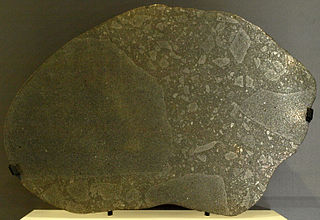 W
WCarbonaceous chondrites or C chondrites are a class of chondritic meteorites comprising at least 8 known groups and many ungrouped meteorites. They include some of the most primitive known meteorites. The C chondrites represent only a small proportion (4.6%) of meteorite falls.
 W
WEnstatite chondrites are a rare form of meteorite thought to comprise only about 2% of the chondrites that fall on Earth. Only about 200 E-Type chondrites are currently known.
 W
WMesosiderites are a class of stony–iron meteorites consisting of about equal parts of metallic nickel-iron and silicate. They are breccias with an irregular texture; silicates and metal occur often in lumps or pebbles as well as in fine-grained intergrowths. The silicate part contains olivine, pyroxenes, and Ca-rich feldspar and is similar in composition to eucrites and diogenites.
 W
WNonmagmatic meteorite is a deprecated term formerly used in meteoritics to describe iron meteorites that were originally thought to have not formed by igneous processes, to differentiate them from the magmatic meteorites, produced by the crystallization of a metal melt. The concept behind this was developed in the 1970s, but it was quickly realized that igneous processes actually play a vital role in the formation of the so-called "nonmagmatic" meteorites. Today, the terms are still sometimes used, but usage is discouraged because of the ambiguous meanings of the terms magmatic and nonmagmatic. The meteorites that were described to be nonmagmatic are now understood to be the product of partial melting and impact events and are grouped with the primitive achondrites and the achondrites.
 W
WThe ordinary chondrites are a class of stony chondritic meteorites. They are by far the most numerous group and comprise about 87% of all finds. Hence, they have been dubbed "ordinary". The ordinary chondrites are thought to have originated from three parent asteroids, with the fragments making up the H chondrite, L chondrite and LL chondrite groups respectively.
 W
WThe pallasites are a class of stony–iron meteorite.
 W
WPrimitive achondrites are a subdivision of meteorites. They are classified on the same rank and lying between chondrites and achondrites. They are called primitive because they are achondrites that have retained much of their original chondritic properties. Very characteristic are relic chondrules and chemical compositions close to the composition of chondrites. These observations are explained as melt residues, partial melting, or extensive recrystallization.